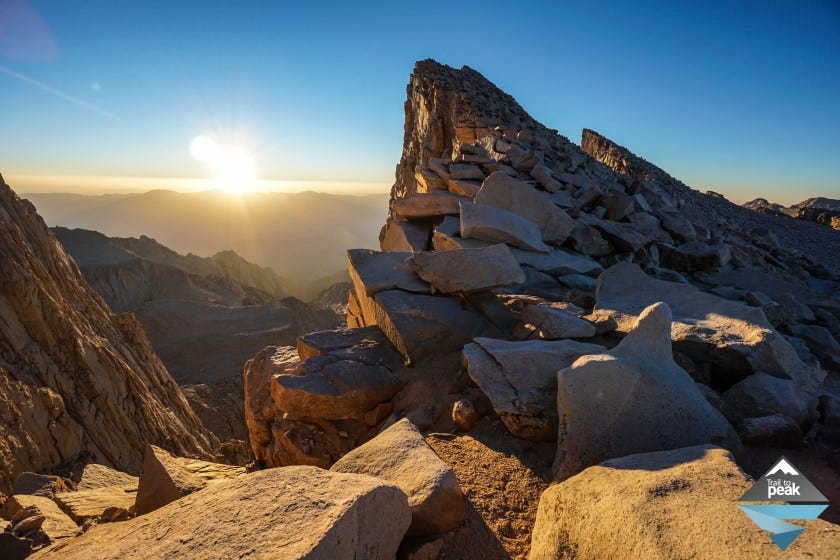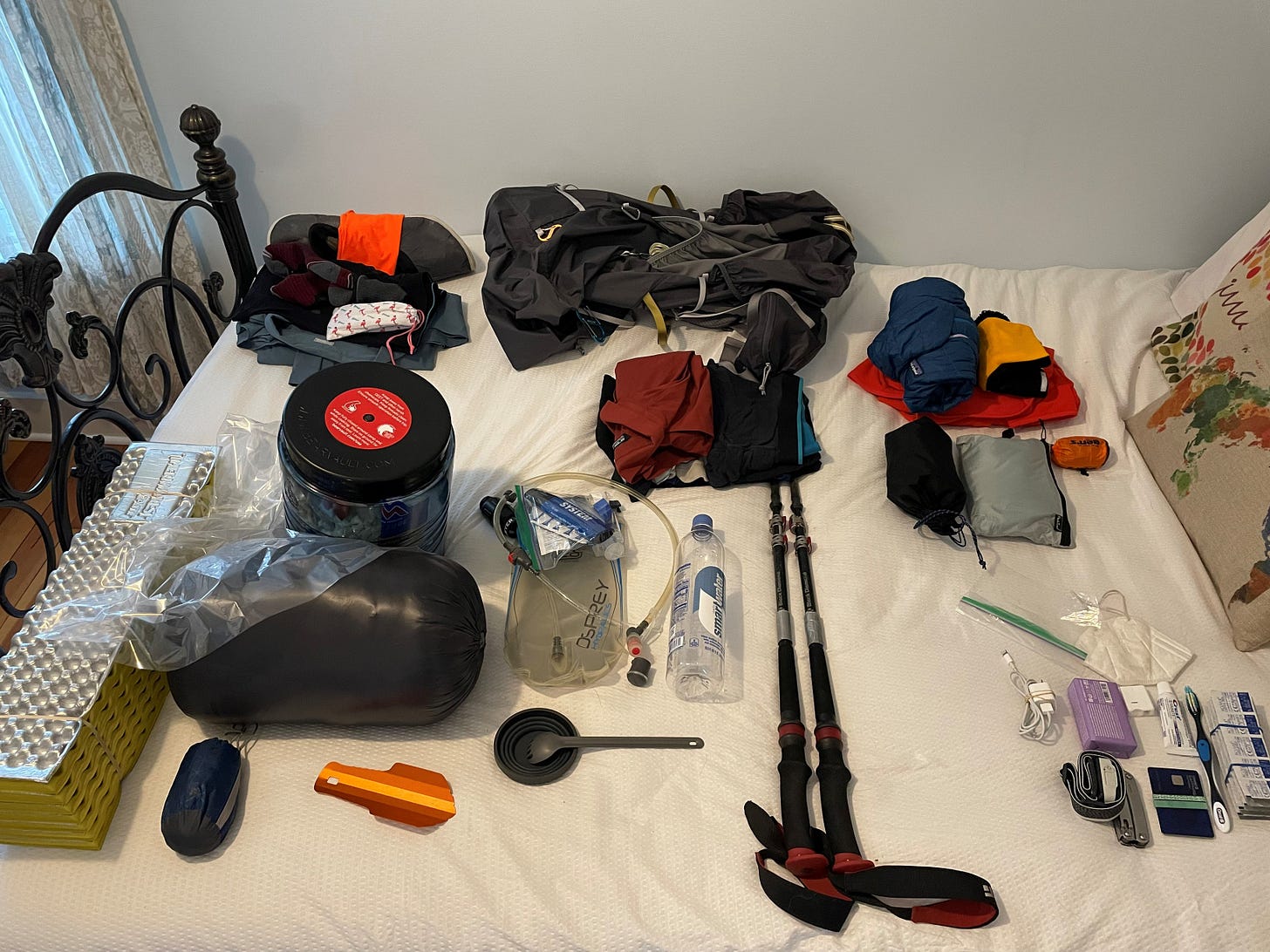As mentioned in this week’s blog post, I’m hiking the John Muir Trail (JMT) — woo!
Starting on June 26th, I’ll be spending ~2.5 weeks hiking from Mount Whitney through the Sierra Nevada mountains all the way to Yosemite National Park. This 200+ mile journey is a coveted bucket list hike for visitors around the world so I feel fortunate have the opportunity to make the venture.
A BIG kudos to my friend and permit wizard Jack Sweeney who secured the hiking permits and planned the entire trip! (only ~5% of permits are granted each year)
While this is a non-traditional Climate Musings edition, due to the sustainability lean of this crowd I wanted to share and hopefully inspire others to enjoy the great outdoors (while we still can!)
I hope you enjoy these fun facts, climate relevant data, scenic views, and even my packing list!
Fast (and fun?) facts 🎈
There are countless well-written, uber-comprehensive blogs about the JMT that I’d recommend perusing as you dive further into this epic thru-hiking journey.
Accordingly, allow me to share a few stats that I found interesting, insightful, and fun during my planning and educational journey:
⛰️Length & elevation: the traditional JMT trail is 210 miles (our pathway is ~240 miles) and nearly 45,000 feet in elevation gain climbing 10 mountain passes each over 10K feet. Intense! The trip takes anywhere from 10 to 30 days to complete.
🍔 Food & calories: I’ll be burning >5,000 calories a day on the JMT. To stay fueled, I’m packing ~3,500 calories of food per day — all of which has to fit into an 11.5L bear can, in increments of 8 days / 4 days / 4 days considering food resupply. This means I’ll expect to lose nearly 10 pounds along the way. Fortunately I’ve built up some cushion for the pushin’ so the fat won’t be missed!
🎒 Packing & planning: At my heaviest (~8 days of food) I’ll be carrying 30-35 pounds on my back — 20 of those pounds being food and water. At my lightest, I’ll be carrying only about 15 pounds (this is generally referred to as your “base weight” — essentially everything minus the clothes you wear and food / water). Folks go crazy trying to get their base weight as low as possible with the latest & greatest gear — my efforts took me from 22lbs -> 14lbs… so I’ll take it!
🥾Trip planning: As mentioned, the trail goes from Mt. Whitney to Yosemite National Park and is a piece of the larger Pacific Crest Trail. Most folks travel southbound, with prime time hiking landing in the July and August timeframe due to snowpack and weather conditions. We’ll actually be heading northbound so starting at Mt. Whitney (the tallest peak in the continental US).
Climate say what?
I can’t get away with a Climate Musing without some climate data… right?
Let’s talk about snow (❄️) and fire (🔥)
A silver lining of climate change… lower amounts of snowpack? (not really…)
We don’t expect to hike on any snow during our journey. For a late-June trip, this is extremely rare. Two years ago when we hiked Mt. Whitney for the first time, it was a month later in the season and we still saw snow on the landscape.
While this is bad news for the climate, it allows us to avoid carrying extra gear (cramp-ons, ice axe) and makes traversing the streams we’ll cross safer.
Check out the snow pack data below, it’s like we’ve fast forwarded the snow pack for 2021 by 1-2 months.
For the other side of the climate equation, wildfires are an increasingly top-of-mind concern for those traveling on the PCT or JMT.
As has been written, 2021 and these past few weeks have been historically dry and hot. One example - Death Valley has set this year’s record for the hottest temperature on Earth (128 degrees F) and almost broke its own June record of 129F set back in 2013.
This heat and drought has made wildfires an unexpected concern starting so early in the season. Specifically, the Inyo Creek Fire has currently shut down Whitney Portal through June 27th. This is less critical for our hike as we are starting a bit south of the Portal and “sneaking up” behind Mt. Whitney, but it still may cause some headaches as we get closer to starting our hike on Saturday.
Check out more on the fire status around California here
I can only imagine what the conditions will be like in August…
#scenic
I’ll save the photo sharing for after the trek, but for those looking to get a taste here are a few of the sights I’m most excited about seeing in person…
(Picture credit: Trail to Peak, link here)
r/Ultralight ⛺
And last but not least — besides carrying my old bag of bones up and down the mountains, I’ve got to carry a pack as well!
As mentioned, serious hikers obsess about getting their carrying weights as low as possible - and for better or worse, I’ve caught the bug over the past month or so.
The rules of thumb for the JMT base weights are as follows:
Out of this world: <10 lbs
Kicking butt: 10-15 lbs
Not too shabby: 15-20 lbs
Left-to-be-desired: >20 lbs
While I’m proud of my ~14lb base weight, I’m not as proud of what I spent on new gear to get there…
If you’re interested in exactly what I’m bringing, check out my gear list1 here!
Wish me luck! 🍀
I hope some of you enjoyed this climate-tangential post.
I’ll be off the grid for a while so you might not be hearing from me for a few weeks. However, when I’m back I promise to have a greater appreciation for nature and sustainability more broadly that I will share through my future Musings.
Thanks for tuning in and until next time…
Perks of hiking with a buddy — the tent and jet boil are on Jack’s list!








